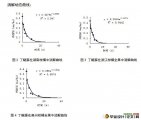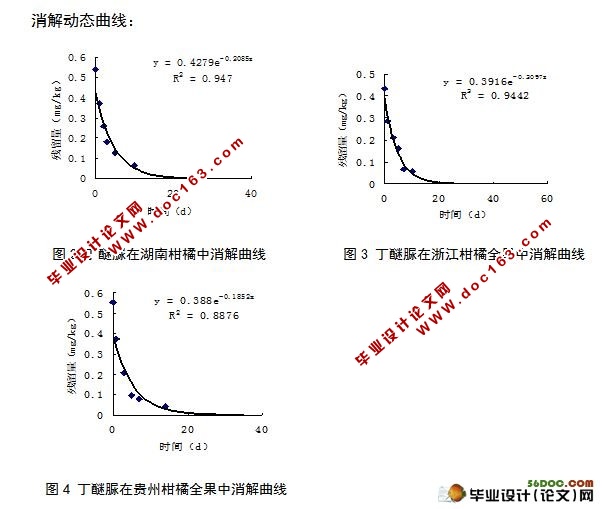丁醚脲在柑橘中的消解动态研究

丁醚脲在柑橘中的消解动态研究(8300字)
摘 要:采用田间试验方法,研究了丁醚脲在柑橘园中柑橘的消解动态规律。采用乙腈提取, 称取10g样品(精确到0.1g)于50ml离心管中,准确加入10ml乙腈溶液,于30℃ 150r/min转速下震荡提取10min,加入1gNaCl和4g无水Na2SO4继续震荡1min后于3500r/min下离心5min。取2ml上清液于已加入50mgPSA吸附剂的离心管中,震荡10min后离心过膜,然后用高效液相色谱检测。实验结果表明:丁醚脲在三个浓度水平(0.20、0.50、2.00 mg/kg)下的平均添加回收率分别为91.68%、93.79%、85.01%,变异系数分别为8.29%、9.55%、8.59%。噻虫胺在土壤中的消解符合一级化学反应动力学模式C=C0e-kt,丁醚脲在长沙、杭州和贵阳柑橘的半衰期分别为3.32d、3.37d、3.74d,该药属于易分解农药(T1/2<30d)。
关键词:高效液相色谱;丁醚脲;消解动态;柑橘;
Oranges biotic insecticides diafenthiuron liquid of dynamic degradation
Abstract: Using field test methods,we study diafenthiuron in Citrus Orchards of Citrus digestion dynamics. Using 10g samples of the residue of diafenthiuron by acetonitrile extraction we extract concentration after chromatography column with concentrated again after the capacity, chromatographic methanol high performance liquid chromatographic detection. In three concentration level of 0.20、0.50、2.00 mg/kg,diafenthiuron in all three citrus fruit respectively for 91.68% ,93.79% ,85.01%, comprehend start ontimeand 8.29%、9.55%、8.59%; Citrus groves citrus fruit of all diafenthiuron residual value is the lowest/kg, minimum detection. The citrus diafenthiuron the digestion dynamics experimental results show that: diafenthiuron the digestion in citrus chemical reaction dynamics model with level C = C0e - kt, changsha, hangzhou ,guizhou the half-life of three respectively citrus 3.32d, 3.37d.,3.74d ,The drug belongs to the easy decomposition of pesticides(T1/2<30d). [资料来源:www.doc163.com]
Key words: HPLC; Diafenthiuron; Dynamic degradation; oranges.
[资料来源:www.doc163.com]

目 录
摘要 ……………………………………………………………………………………1
关键词……………………………………………………………………………………1
1 前言…………………………………………………………………………………2
1.1农药的使用现状…………………………………………………………………2
1.2 丁醚脲的作用机理和毒性………………………………………………………3
1.3丁醚脲的研究现状………………………………………………………………4
2 试验材料……………………………………………………………………………5
2.1 主要试验材料……………………………………………………………………5 [资料来源:Doc163.com]
2.2 主要仪器与装置…………………………………………………………………5
2.3 主要试剂…………………………………………………………………………5
3 试验方法……………………………………………………………………………5
3.1 田间试验设计……………………………………………………………………6
3.2 残留量测定方法…………………………………………………………………6 [资料来源:http://doc163.com]
3.2.1 高效液相色谱条件………………………………………………………6
3.2.2 标准曲线绘制……………………………………………………………6
3.2.3 样品制备…………………………………………………………………6
3.2.4 样品前处理………………………………………………………………7
3.2.5 精密度和准确度…………………………………………………………7 [版权所有:http://DOC163.com]
4 实验结果分析与讨论…………………………………………………………………7
4.1 色谱条件选择……………………………………………………………………8
4.2 线形范围和检测限………………………………………………………………8
4.3 准确度和精密度试验……………………………………………………………9
4.4 消解动态实验……………………………………………………………………9
[资料来源:Doc163.com]
5结束语………………………………………………………………………………12
参考文献 ……………………………………………………………………………13
致谢……………………………………………………………………………………14 [资料来源:http://www.doc163.com]
